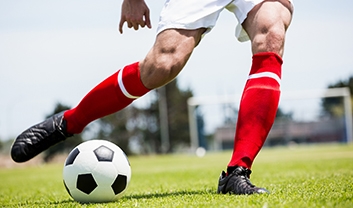
Whether you're playing soccer, lacrosse, or track and field, spring sports demand agility and quick movement—both of which can increase the risk of knee injuries. Proper preparation can help prevent painful setbacks and keep you performing at your best. Here’s what you need to know to safeguard your knees.
Why are ACL Injuries so Common?
The ACL is a key ligament that stabilizes the knee joint. Quick changes in direction, sudden stops, jumping, and pivoting—common in many spring sports—can put excessive strain on it, leading to tears. The other knee ligaments are also at risk, with MCL injuries common from blows to the outside of the knee, PCL tears typically caused by direct impact, and LCL damage being the least frequent, requiring extreme force.
Tips to Prevent Knee Injuries
Strengthen Your Leg Muscles: Strong muscles support the knee and reduce stress on ligaments. Focus on quadriceps, hamstrings, glutes, and core strength with exercises like squats, lunges, and hamstring curls.
Improve Your Balance and Stability: Balance training enhances neuromuscular control, reducing awkward landings and missteps that lead to injury. Single-leg exercises, agility drills, and stability ball workouts can improve knee stability.
Warm Up and Stretch Properly: A proper warm-up prepares your muscles and ligaments for movement. Dynamic stretching (leg swings, high knees) increases flexibility, while static stretching after activity helps maintain muscle elasticity.
Learn Proper Jumping and Landing Techniques: Many ACL injuries occur from improper landings. Athletes should practice bending their knees, keeping weight evenly distributed, and landing softly to absorb impact safely.
Wear the Right Footwear and Braces if Needed: Supportive shoes with good traction help prevent slipping and awkward movements. Some athletes with previous injuries may benefit from knee braces to provide additional support.
Avoid Overtraining: Fatigue increases injury risk. Ensure you get adequate rest, hydration, and recovery time between practices and games. If you feel pain or discomfort, seek medical attention early.
If you experience persistent knee pain, swelling, instability, or difficulty moving your knee, it’s important to seek professional care. Many knee injuries can be treated with regenerative orthopedic treatments, such as PRP, which promote natural healing and reduce inflammation.
For more severe injuries, minimally invasive procedures like knee arthroscopy can effectively repair ligament damage with shorter recovery times compared to traditional surgery. Early intervention with the right treatment approach can help you recover faster and get back to the sport you love.
AUTHOR: Dr. Kai Mithoefer is board-certified in both Orthopedic Surgery and Orthopedic sports medicine specialist. Dr. Mithoefer is an internationally recognized specialist for complex shoulder and knee injuries with over 15 years of experience with the treatment of sports-related injuries. Dr. Mithoefer practices at Boston Bone and Joint Institute and has published more than 100 scientific articles and book chapters and is a frequent speaker at national and international orthopedic meetings.











